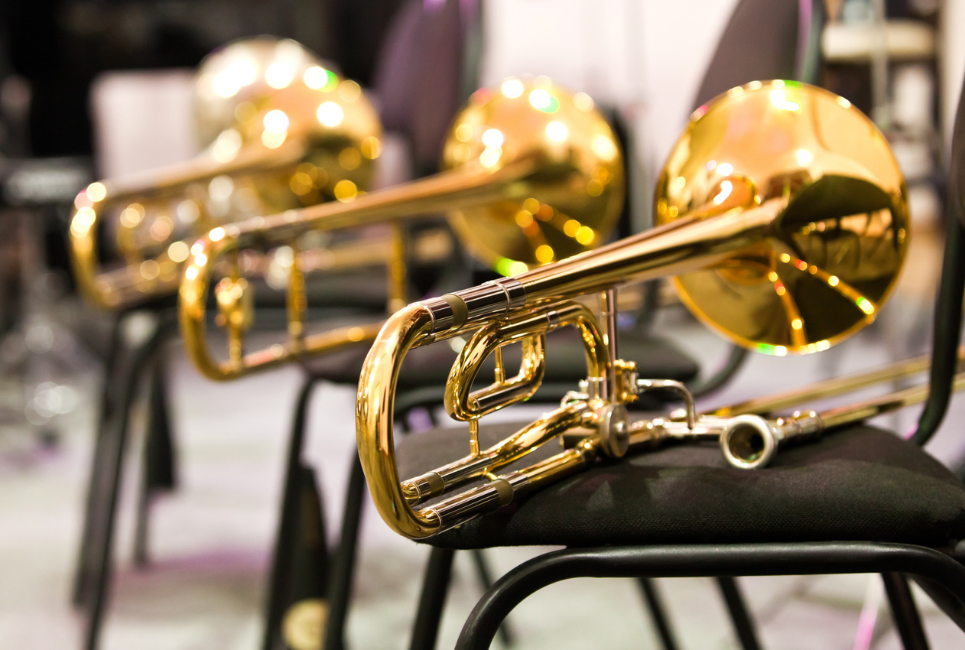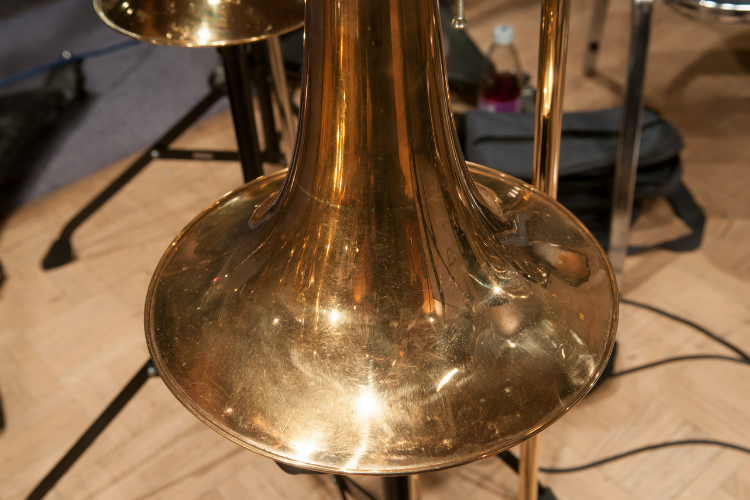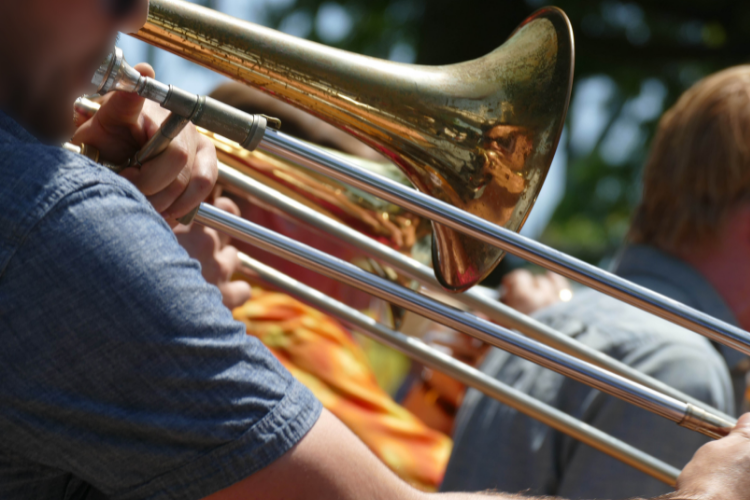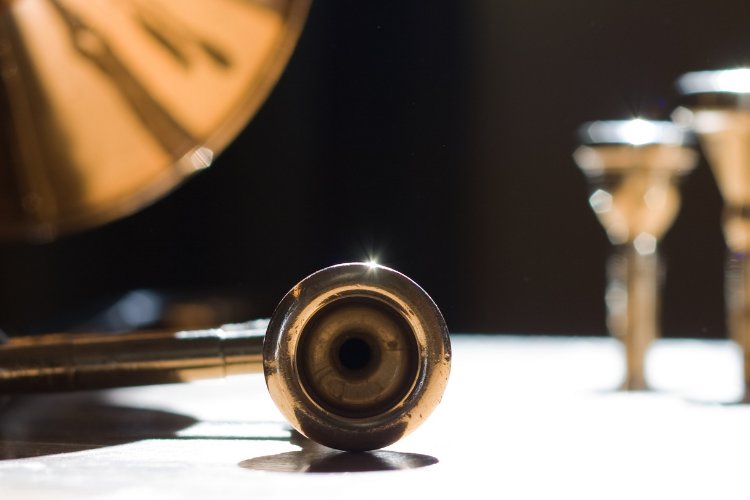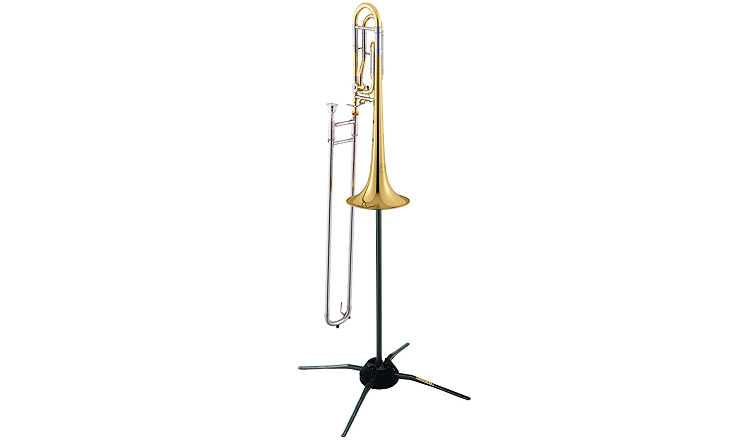- Trombone Parts Explained - December 15, 2021
- Cello Sizes Explained: Find The Perfect Size For You! - October 15, 2021
The trombone’s distinct shape and large musical range make it the standout workhorse of the brass section.
The trombone contains many detailed mechanisms and techniques to help its player bring out all its hidden complexities underneath its straightforward surface. We’re here to tell you all about how they work together to create the instrument’s distinct sound.
With a history dating back to Europe in the late 1400s, the trombone has a long tradition as a staple in every type of music, from Renaissance dance bands and religious ensembles to modern orchestras, marching bands, and jazz groups.
Its name means “big trumpet” in Italian, and although it shares a few traits with its namesake brass cousin, the trombone has a construction that necessitates an entirely unique playing style.
Unlike other brass instruments, a trombone does not have valves a player presses to reach different notes in conjunction with buzzing into the mouthpiece.
Instead, a trombone player moves the instrument’s slide further and closer to themselves in a smooth gliding motion as they use the standard brass pursed-lips buzzing technique on the mouthpiece. That means the trombone has a unique construction that we will explore further below.
There are three main sections of a trombone: the bell, the slide, and the mouthpiece. Within each of those sections, the instrument contains a number of smaller parts that refine the instrument’s use.
The Bell
Like a trumpet, the trombone’s bell is a conical shape that flares around its outer edges to amplify and project the vibrations that travel to it from the mouthpiece through the rest of the instrument.
In the playing position, it sits directly over the slide and slightly ahead of the player’s left shoulder. (This forward push of sound makes the trombone an excellent addition to marching bands.)
In addition to the bell itself, this section of a trombone contains several other construction pieces.
Slide Receiver
This is the junction where the bell connects to the trombone’s slide. They connect through a threading system strengthened by a tightening bolt.
Bell Braces
The back tubing of the bell curls in on itself in a long U to connect to the mouthpiece. Bell braces are two straight pieces of metal that are situated in the middle of that U to make sure the tubing does not collapse in on itself.
Tuning Slide
The bell braces also provide structure for the tuning slide, which is the adjustable bottom curve of the U. A player can move this curve in and out of its slot to make the trombone’s tubing a bit longer or shorter, which can in turn adjust the instrument’s overall tone to the player’s liking.
Some players don’t bother with tuning slides, preferring to rely solely on their embrasure adjustments and slide positions, but they should not neglect to keep the tuning slide oiled and maintained so it stays in as good a condition as the rest of the instruments.
The Slide
As the unique heart of a trombone, the slide earns special significance in the instrument’s construction. It’s another moveable U-shaped piece of tubing that sits right under the bell and glides forward out of and back into the rest of the trombone.
It connects the mouthpiece and the bell, and a player moves it to specific lengths to hit specific notes. The slide’s smooth motion adds a glissando touch that valve-based brass instruments can’t replicate.
A trombone’s slide works with several other pieces to support the middle of the instrument.
Inner Slide
This piece nests inside the outer slide in a telescopic connection. Their connection is what allows the inner slide to move in and out to alter the instrument’s tubing length and, therefore, sound.
Outer Slide
The outer slide is a tube that encloses the inner slide. Its diameter is only slightly larger than the inner slide’s to facilitate the slide movement without adding bulk to the instrument.
Slide Braces
These are two parallel pieces of metal that connect the top and bottom tubes of the slide. The brace that is closest to the player is held for stabilization, and the one further from the player is used as a grip to move the slide.
Slide Lock
When the inner and outer slide come together, they can be locked into place through a small ring that rotates into place between them. This is very handy for storing a trombone outside of its case because it prevents the instrument from extending to its full length unexpectedly.
Mouthpiece Receiver
This is where the mouthpiece connects to the rest of the trombone. It’s located on the end of the slide tubing closest to the player.
Water Key
Unfortunately, playing any brass instrument produces a lot of saliva. Fortunately, like all of its brass brethren, the trombone has a water key (colloquially known as the spit valve).
As its nickname implies, this is a lever that opens a small hole in the slide so that accumulated saliva can be dumped out when it builds up too much. Gross but necessary.
Slide Bumper
On the outer side of the slide’s U bend, its tubing is topped with a small piece of metal. This is to protect the end of the slide from getting too dinged up.
Dents are still common in trombones, especially for those instruments played in ensembles where space is limited, but the slide bumper keeps the damage at a minimum and, as a bonus, adds a way to prop the trombone at a convenient angle for extended rests.
The Mouthpiece
As the trombone’s source of the player-driven sound, the mouthpiece scores a starring role in the instrument’s showcase. Overall, the mouthpiece is shaped like a small cup with a short tube that connects the bowl to the rest of the instrument.
A musician purses their lips and buzzes into this to produce the necessary vibrations that come out of the bell as notes. Although all mouthpieces consist of the same parts, they vary in size and shape to work with different players’ skill levels and style preferences.
Rim
As the circular ridge against which you place your lips, the rim’s shape has a big influence on the tone range a player can achieve with their trombone. A flatter rim is easier to play, but does not give the lips as much room for shaping tone, and a rounded rim is the opposite — more difficult to play properly, but rewarding in its range.
Cup
The depth of this hollow right behind the rim affects playing tone as well. The bigger the cup (and the larger the mouthpiece in general), the deeper and more mellow the instrument’s sound will be. Conversely, smaller cups create brighter tones and make it easier to reach high notes.
Throat
This is the hole in the bottom of the cup. Its diameter controls the airflow that goes through the mouthpiece into the rest of the trombone, and it’s usually proportional to the size of the cup (i.e., a larger cup will be accompanied by a larger throat).
Backbore
Also called “the bore,” this is the short tube that connects the rest of the mouthpiece to the slide. Trombone mouthpieces with large bores have a darker sound that blends into orchestral music better, while those with small bores sound sharper and are great for making the instrument stand out in jazz and pop.
Optional Pieces
Like any other instrument, the trombone is capable of modification through a number of external accessories. We’ll go through the most frequently used below.
Bell Mute
This is a piece of rubber or cork that is held over the trombone’s bell, either by cork grips or the player’s hand. Several other brass instruments use this same type of sound modification, and it affects a trombone’s tone the same way, making it flatter and broader to create a wah-wah sort of phrasing that lends itself well to jazz and Dixieland.
Valve Attachments
The majority of trombones do not come with the valves that the rest of the brass family sport. However, they operate on the same principle of forcing air through a series of tubing, and players can attach valves if they want to add musical range, use alternative slide positions, or both.
Using a valve that hitches to a specific spot on the side of the trombone’s midsection, a musician can drop their instrument’s tuning or flutter between notes more cleanly than with a slide alone. The most common type of valve attached to a trombone is a rotary valve, which (as the name implies) rotates open and closed.
This is more ergonomic for a trombone player to use in that position than piston valves, which are the type that goes up and down like on a trumpet.
Trombone Stand
A trombone is heavy, especially when factoring in the user’s own arm weight used to hold the instrument in a playing position. Therefore, a place to set the trombone during practice breaks and long stretches of rests within the music itself is a smart purchase.
Trombone stands are essentially small metal poles with a rubber stopper at one end and a tripod of feet at the other. The bell of the instrument goes into the stopper, and the feet go on the ground so that the trombone is stored vertically with the bell facing the floor.
That saves room and the player’s arms in a crowded space such as orchestra practice while keeping the instrument secure from getting knocked over.
Frequently Asked Questions
Answer: The standard tenor trombone is about three feet long when the slide is tucked all the way into the instrument’s body. When the slide is fully extended, the trombone’s length almost doubles. The diameter of its bell can vary from seven to nine inches, although many European regional varieties go outside this range.
A tenor trombone can weigh anywhere from three to a hair over six pounds, depending on if any valve attachments are anchored to it. Players also have to deal with the additional weight of holding up their arms since both are braced in that position the whole time they play.
Answer: Traditionally, trombones are made from brass, much like the other instruments in their namesake musical family. There are different types of brass achieved by mixing different percentages of copper and zinc, but those are always the primary two elements to achieve that type of metal.
Plastic trombones have become a popular alternative since the 2010s or so. They’re lighter than brass, and with an instrument that’s held straight out while you play, that can be a relief for players with arm or shoulder issues.
Plastic is also cheaper and as such is touted as a great alternative for beginners and those who want to try out the instrument before committing fully to it. Plus, plastic trombones can be made in a variety of fun colors!
Answer: The signature of a traditionally-structured trombone is the use of a slide rather than a row of valves to produce different notes. However, many trombone players add valve attachments to their instruments so that they end up with a hybrid of both.
The musician presses the valves while still using the slide, which allows for both an extension of musical range and alternate slide positions that may help play specific note transitions easier.
There is also a type of trombone called a valve trombone, which retains the shape and amount of tubing of a traditional trombone so the sound is the same but has a row of valves on its top that the player uses like a trumpet’s.
This allows for faster playing than a slide or slide and valve combination, although the sound quality can be said to be muffled compared to the alternative.
Answer: Like many instruments, trombones are made in a range of sizes that correlate with their musical range. The most common type is the tenor trombone. The bass, contrabass, and cimbasso trombones are all pitched increasingly lower, while the alto, soprano, and piccolo trombones are pitched progressively higher.
In addition to different pitches (and relative sizes), trombones come in several varieties of hybrid models. The superbone is a hybrid of the valve trombone mentioned above and a standard slide trombone; both sets of mechanisms are fully operational for the player to use in any combination they want.
The historical sackbut and its smaller bell was popular in the Renaissance and Baroque eras; the buccin ended with a bell-shaped like a dragon or serpent and sounded a little like a French horn.
Final Thoughts
The trombone’s construction rewards players with a unique playing experience that puts a wide range of control into their hands. The instrument is a master class in elegant, deceptive simplicity when all its parts come together.
Looking for more interesting readings? Check out:

